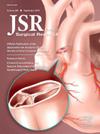Quantitative and Qualitative Analysis of Clinical Trial Acronyms From Surgical Journals
IF 1.8
3区 医学
Q2 SURGERY
引用次数: 0
Abstract
Introduction
Acronyms, the short form of a word or phrase, are commonly used in medical research to identify studies. However, their usage and quality assessment in surgical journals are unclear. This study aimed to determine the impact of identifying acronyms for clinical studies on the number of citations by comparing studies published in surgical and medical journals.
Methods
Articles were screened from five highly cited journals (Annals of Surgery, British Journal of Surgery, JAMA Surgery, Journal of the American College of Surgeons, and New England Journal of Medicine, alphabetically). The correlation between acronym use and number of citations was analyzed. In addition, the characteristics and quality of acronyms, in terms of lettering and wording scores, used to identify studies were evaluated for acronymous trials using a developed and self-validated scoring tool.
Results
Of 291 eligible articles, 167 (57.4%) were acronymous studies. Although 70.5% (122/173) of articles in general medical journals used identifying acronyms, only 38.1% (45/118) used them in surgical journals (P < 0.001). The median number of citations was higher for acronymous studies (212 versus 53; P < 0.001). Multivariable analysis revealed that acronymous studies had a 2.5-fold higher possibility of being a highly cited (odds ratio 2.514, P = 0.004). The average quality scores of the acronyms were similar for surgical and general medical journals (5.1 ± 1.7 versus 5.1 ± 1.6, P = 0.949). Surgical journals had lower lettering (2.20 ± 1.14 versus 3.02 ± 1.04, P < 0.001) but higher wording scores (2.89 ± 1.01 versus 2.09 ± 1.14, P < 0.001) than general medical journals.
Conclusions
Given the publicity effect of acronyms, a memorable acronym devised using the first or continuous letters for surgical studies may help recognize their clinical impact.
求助全文
约1分钟内获得全文
求助全文
来源期刊
CiteScore
3.90
自引率
4.50%
发文量
627
审稿时长
138 days
期刊介绍:
The Journal of Surgical Research: Clinical and Laboratory Investigation publishes original articles concerned with clinical and laboratory investigations relevant to surgical practice and teaching. The journal emphasizes reports of clinical investigations or fundamental research bearing directly on surgical management that will be of general interest to a broad range of surgeons and surgical researchers. The articles presented need not have been the products of surgeons or of surgical laboratories.
The Journal of Surgical Research also features review articles and special articles relating to educational, research, or social issues of interest to the academic surgical community.

 求助内容:
求助内容: 应助结果提醒方式:
应助结果提醒方式:


